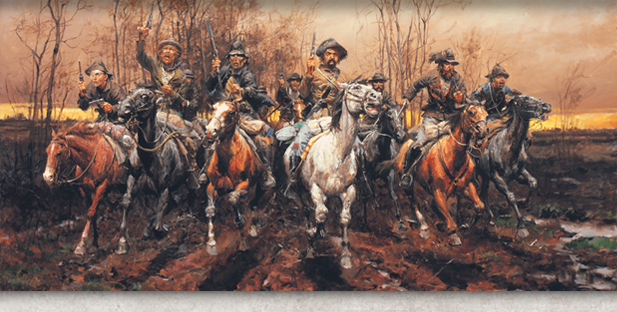Life in the Ozarks

By 1860, Missouri’s demographics had changed dramatically since its entry into the Union as a slave state in 1820. Native Southerners settled along the Missouri River where slavery thrived with the production of hemp and other cash crops. By 1860, 77 percent of Missouri’s 114,509 slaves resided in this area known as “Little Dixie.”1 Emigrants from Tennessee, Kentucky, and Virginia settled in the Ozarks, where they found a landscape similar to their native state. By the 1850s, approximately 75 percent of Missourians claimed Southern ancestry.2 St. Louis however, experienced a period of explosive growth and challenged the planters for political and economic dominance. Here a large population of immigrants, especially Germans and Irish thrived. Their presence worried many early settlers who feared a loss of Missouri’s Southern heritage.
The economic wealth of most Missourians came from hard work on the land. The Ozarks had very few slaves, and were primarily settled by small white farmers. While tobacco and cotton was grown in the Ozarks, the terrain of the region made it difficult for mass production of these cash crops. Instead, farmers grew corn and other cereal grains for consumption.
Springfield, Missouri was the largest city in the Ozarks by 1860. She thrived along the James and Sac Rivers, which provided an ample water supply for agricultural production. Smaller urban centers such as Carthage, in Jasper County, Missouri, and Rolla in Phelps County, Missouri, developed alongside an itinerant population traveling what became permanent roads. By 1860, Rolla, was the railroad terminus of the Ozarks and became an integral part of the Union war effort by supplying goods, troops and equipment from St. Louis to the remote region. Fort Scott, Kansas and Fort Smith, Arkansas were both mid-century military encampments that grew with the urban Ozarks. The presence of soldiers on the frontier provided help and comfort to families facing the possibility of Native American attacks and partisan violence in the years before the war.
The struggle over Kansas in the mid 1850s was a pointed example of the fears brewing in the South. Southerners wanted an equal number of free and slave states to maintain a balance of power in Congress. They also hoped to extend slavery into the territories that were acquired after the Mexican War, 1846-48. With the passage of the Kansas-Nebraska Act in 1854, Kansas was opened to settlers. Hoping to make Kansas a slave state, bands of Missourians rode into Kansas and cast fraudulent votes. As tensions rose between Kansas and Missouri, hatred spilled across the countryside. The issue of slavery was now pushed to the forefront for many families. Violence erupted along the Kansas and Missouri border, turning neighbors against one another. The Bleeding Kansas era began a cycle of guerrilla warfare that plagued the region for the next decade.
Sectional tensions were at an all time high in the months before the 1860 presidential election. Southerners threatened secession, and issues of slavery, popular sovereignty, nationalism and state’s rights were fiercely debated. The new Republican Party and its candidate, Abraham Lincoln was at the center of the controversy. Lincoln and the Republicans vowed to preserve slavery where it existed, but were determined to keep it out of the territories. Many slave owners saw Lincoln’s victory as a denial of their constitutional property rights, which left them no choice but to leave the Union. On December 20, 1860, South Carolina approved an Ordinance of Secession. Six weeks later, another six Southern states seceded. Secession conventions were held across the border states. A secession convention met in St. Louis in March 1861, but voted to keep Missouri in the Union.
Many Missourians wished to remain neutral. They opposed leaving the Union, and yet were against perceived Northern aggression. Missouri became an “armed neutral” and vowed to defend her borders from all aggressors. War came to Missouri in May 1861. Union general Nathaniel Lyon captured a pro-secessionist militia encampment on the outskirts of St. Louis, but during an ensuing riot his troops killed 28 civilians. Governor Claiborne Jackson and the legislature abandoned the capital at Jefferson City to Lyon’s troops. Missouri’s secession convention met again and dissolved the legislature and removed the governor from office. They were replaced by a Provisional Union Government with Hamilton Gamble as governor. Southern legislators passed an ordinance of secession at Neosho in October 1861 and Missouri was admitted to the Confederacy. Thus, Missouri had two governments, a Confederate administration in exile which operated from Arkansas and Texas, and the Provisional Government supported by the United States army.
A decisive Union victory at Pea Ridge, Arkansas in March 1862 prompted both sides to shift most of their troops east of the Mississippi River. The Ozarks became a backwater of the war where guerrillas terrorized the civilian population. The violence that emerged did not discriminate among those who wished to remain neutral, the elderly, women or children. War spilled over from the battlefields and onto the doorsteps, as bushwhackers and jayhawkers rampaged through the Ozarks. No one was safe, as neighbors, friends and families all turned on one another when the Civil War came to the Ozarks.
Painting at top of page: ‘Guerrillas’ by Andy Thomas
- James Denny and John Bradbury Jr, The Civil War’s First Blood: Missouri, 1854-1861 (Boonville: Missouri Live, 2007), 3.
- Denny and Bradbury, The Civil War’s First Blood, 3.












